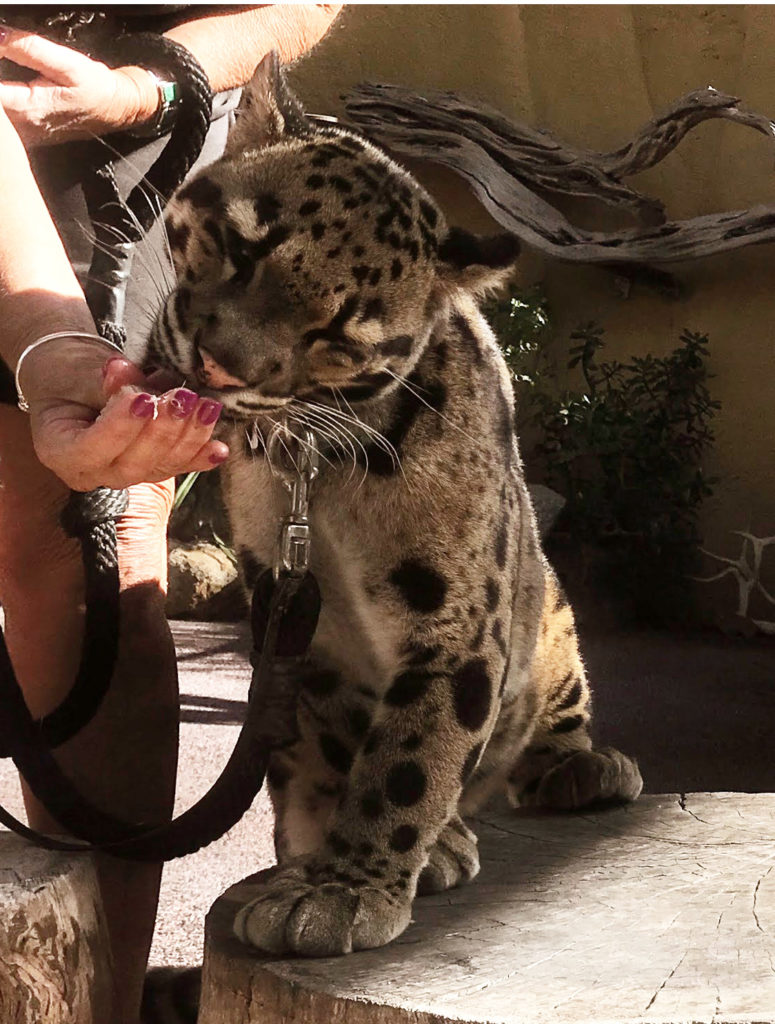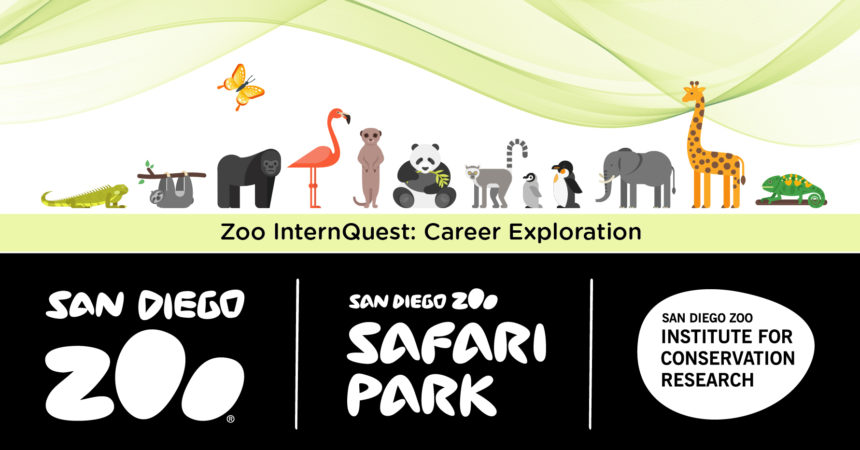Zoo InternQuest is a seven-week career exploration program for San Diego County high school juniors and seniors. Students have the unique opportunity to meet professionals working for the San Diego Zoo, Safari Park, and Institute for Conservation Research, learn about their jobs, and then blog about their experience online. Follow their adventures here on the Zoo’s website!

Paloma is a two-toed sloth who enjoys corn and hibiscus. However, Ms. Elkins informed us that she goes absolutely “gaga” over peanuts. She enjoys basking in the sun on warm days.
Have you ever wanted to know what it’s like to work with the San Diego Zoo’s animal ambassadors? Kelly Elkins is the lead animal trainer of the Animal Connections department here at the Zoo. She has the special job of managing both people and animals, meaning when she isn’t training animals, she oversees the trainers in her department by helping them make the right decision. This department specializes in working with animal ambassadors (animals that represent their entire species), of which the interns were fortunate to meet a few. Trainers respectfully highlight animals’ natural behaviors through guided up-close interactions that educate the public. This job allows Ms. Elkins to work closely with a wide range of animals from red kangaroos, cheetahs, and zebras, to flamingos and sloths, which is why her job at the Zoo is so enjoyable everyday.

Ganda initially came to the Zoo as an animal ambassador. Clouded leopards are not considered big cats, nor are they considered small cats, because they can purr and roar. In this picture, she is receiving a much-deserved neck massage.
Ms. Elkins introduced us to a few animals, one being the clouded leopard Ganda. You would think that Ganda would need a colorful diet in order to maintain her beautiful coat, but the majority of what she eats is meat. Their short and stubby legs were not built for running, but for climbing trees and moving from branch to branch. In the wild, clouded leopards can rotate their feet 180 degrees to hang from a tree branch and catch their prey. They aren’t categorized as big cats but they’re too big to be a small cat, so they’re known as a middle ground species. Due to deforestation, clouded leopards in the wild suffer from habitat loss and habitat fragmentation, leading to the species being endangered. For this reason, Ganda was brought to the San Diego Zoo to be an animal ambassador. Another reason she was brought to us is the fact that she’s not a well known species, and education is crucial to conservation.

Ms. Elkins’ favorite part of her job is being able to inspire people to help animals in their own lives, and even contribute to San Diego Zoo Global’s goal of ending extinction. A daily part of her job is connecting people to wildlife through animal ambassadors during the Animals in Action Experience. We were introduced to some of these animals, and learned each has their own personality, as well as likes and dislikes. As a lead animal trainer, it’s Ms. Elkins’s job to know them all, and handle the unique challenge that each animal presents. Ms. Elkins says there’s something to learn from every animal. Not just every species, but each individual animal is so unique and special that she can’t pick a favorite. Some animals are more challenging than others, such as apes, pigs, wolves, and zebras. Since trainers spend so much time working with the animals, they develop a lifelong bond and become like family to their human counterparts.

Pictured is Jirra, a female red kangaroo who loves going on walks and eating apples, one of her favorite snacks. Jirra is energetic and people-loving. Kangaroos can actually hold joeys––baby kangaroos––for up to 400 days!
Ms. Elkins’ goal is to help San Diego Zoo visitors learn to love and appreciate the animal ambassadors she works with. The Zoo’s hope is that by allowing and encouraging us to connect with a variety of species, we’ll want to conserve and save animals we love. Ms. Elkins practices conservation outside San Diego Zoo by volunteering with the Cheetah Conservation Fund, and helping to lead the Animal Behavior Management Alliance with her position on the board. Some conservation tips she had for us are to research and buy different zero waste products, switch plastic and paper straws out for reusable metal ones, and download sustainability apps such as the Cheyenne Mountain Zoo Palm Oil app. This app is used to track which products contain palm oil, and if they use sustainably sourced palm oil. By buying sustainable products, you are reducing the demand for palm oil and consequently, decreasing the destruction of rainforest habitats. We can all become heroes for wildlife by educating ourselves on how we can make a positive change for the planet as well as supporting reputable organizations such as the San Diego Zoo and the San Diego Zoo Safari Park.

This is a flamboyance, a flock of flamingos, being called to bed after having a zooper-fun day! After being fed a scrumptious treat from the interns, they were directed to bed by their keeper. The particular treat mixture mimics their food in the wild and allows for the flamingos to filter feed from the cup.
Similarly to most people in her field, Ms. Elkins has always had a soft spot for animals. Growing up, her favorite destination was always either the Zoo or SeaWorld, and nothing brought her more joy than to see the many beautiful animals on exhibit. She briefly explored fields involving animals by working as a vet tech and a dog trainer. Ms. Elkins studied physical therapy before attending Moorpark College, a college known for their animal training program. All her life, Ms. Elkins dreamed of working with animals and she has always been inspired by them. Even while studying physical therapy she longed for a profession that might allow her to not only work with and help animals, but also educate people. To her surprise, approximately a month after graduating, Ms. Elkins was hired at the San Diego Zoo. She now makes a difference in the world through the education of visitors at the Zoo.

This clouded leopard is called Ganda. She is munching on a “chicken- sickle”. This frozen treat is part of her diet, and is used as positive reinforcement during the Animals in Action experience.
Ms. Elkins says getting a job as an animal trainer is more difficult now than when she graduated college. She suggests getting a degree in a subject like biology, zoology, or psychology. Ms. Elkins also recommends volunteering and applying for internships that relate to the career you’re interested in. She believes that when you devote yourself, work hard, and love what you do, you can achieve your goals. Additionally, if you are interested in animal training, Ms. Elkins recommends having patience and being able to change your training approach based on the animal being worked with. For example, working with clouded leopards demands a calm and collected demeanor, while working with macaws requires a more outgoing and energetic approach. Overall, Ms. Elkins is very passionate about her job and feels that hard work and dedication can help you achieve your goals.

This was definitely a very special day for all of the interns! We learned so many interesting facts, like how sloths are actually great swimmers and use the flooding of the rainforest to switch trees, or how the clouded leopard has the largest tail to body ratio! This experience has definitely instilled a greater passion and drive to protect these animals, and there are so many ways for us to help. With power as the consumer, we can stop the palm oil crisis in East Asia that is destroying the rainforests and causing many of these species to not have a home. We can also watch our own pollution and focus on living a sustainable lifestyle. In conclusion, there is so much still to be learned from these animals and the San Diego Zoo is doing a great job making more heroes for wildlife through the Animals in Action program.
Week Two
Fall Session 2019


